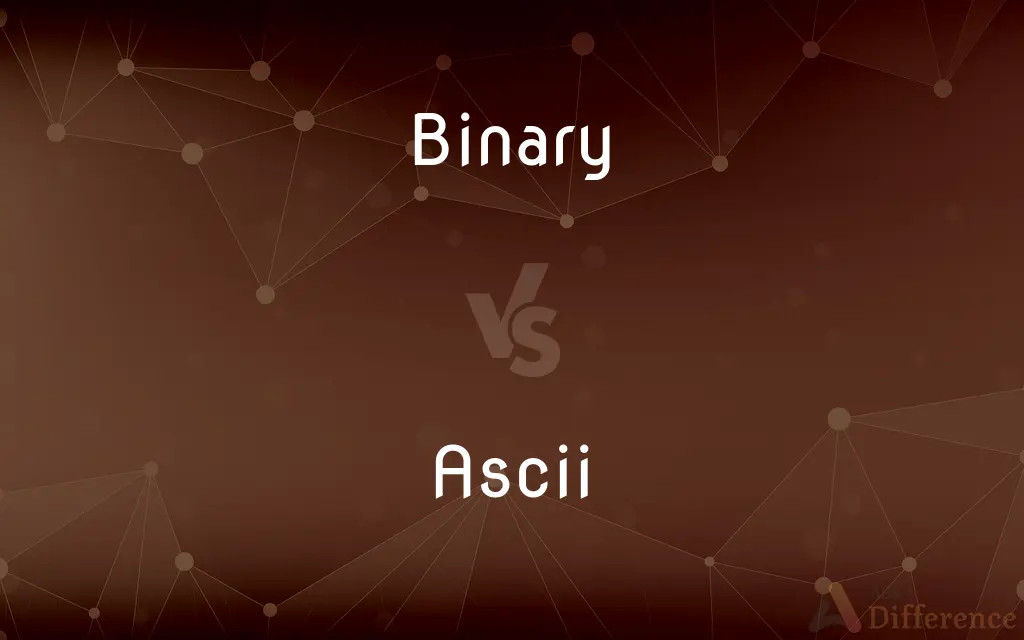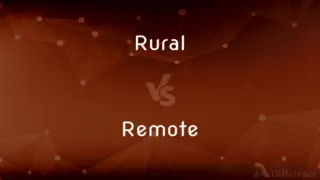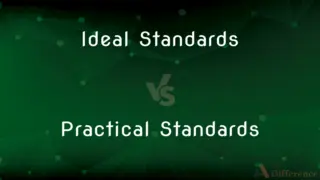Binary vs. ASCII — What's the Difference?
Edited by Tayyaba Rehman — By Fiza Rafique — Published on October 1, 2023
Binary is a base-2 numeral system using 0s and 1s, while ASCII is a standard encoding representing characters using binary numbers.

Difference Between Binary and ASCII
Table of Contents
ADVERTISEMENT
Key Differences
Binary is a fundamental concept in computing and mathematics, rooted in a system that uses only two digits: 0 and 1. These binary numbers serve as the basic language for computers, providing instructions and data processing capabilities. ASCII, on the other hand, stands for American Standard Code for Information Interchange, a character encoding that assigns unique binary combinations to characters, making it possible for computers to represent text.
Binary, with its simplistic nature, is versatile. It not only forms the core language of computers but also represents data, instructions, and more in the digital realm. ASCII utilizes this binary system to assign a specific seven or eight-bit binary code to each character, symbol, or control command, translating human-readable text into something a computer can process.
The core distinction between binary and ASCII is their purpose. While binary is a foundational language comprising 0s and 1s used in various computational contexts, ASCII specifically pertains to character representation using binary combinations. Thus, ASCII is a bridge that facilitates human-computer interaction by encoding text into binary.
Both binary and ASCII are integral to modern computing. Binary's universality across digital systems ensures consistent processing, storage, and communication. In contrast, ASCII's standardized character-to-binary mappings ensure text data is universally understood, regardless of the computer system.
Comparison Chart
Nature
Numeral system
Character encoding standard
ADVERTISEMENT
Elements
Uses only 0 and 1
Represents characters using binary numbers
Purpose
Fundamental computer language
Text representation in binary
Complexity
Simpler, base-2 system
Uses binary but has specific mappings
Representation
Represents data and instructions
Encodes characters for computer processing
Compare with Definitions
Binary
A base-2 numeral system.
Computers process information in binary form.
Ascii
A standard for character encoding.
ASCII allows computers to represent text.
Binary
The foundational language of computers.
Binary uses only two digits: 0 and 1.
Ascii
Facilitates human-computer textual interactions.
ASCII encoding ensures text files are readable across systems.
Binary
A system using only "on" (1) and "off" (0) states.
Binary logic forms the core of electronic circuits.
Ascii
Includes characters, symbols, and control commands.
ASCII contains codes for letters, numbers, punctuation, and commands like 'carriage return'.
Binary
Contrary to base-10 which humans use.
Binary simplifies data representation for machines.
Ascii
Maps characters to binary numbers.
In ASCII, the letter 'A' is represented by the binary '01000001'.
Binary
Relating to, composed of, or involving two things.
Ascii
A universal standard for text representation.
ASCII ensures consistent character display regardless of hardware.
Binary
Relating to, using, or denoting a system of numerical notation that has 2 rather than 10 as a base.
Ascii
A standard for assigning numerical values to the set of letters in the Roman alphabet and typographic characters.
Binary
The binary system of notation
The device is counting in binary
Ascii
Persons who, at certain times of the year, have no shadow at noon; - applied to the inhabitants of the torrid zone, who have, twice a year, a vertical sun.
Binary
Something having two parts.
Ascii
The American Standard Code for Information Interchange, a code consisting of a set of 128 7-bit combinations used in digital computers internally, for display purposes, and for exchanging data between computers. It is very widely used, but because of the limited number of characters encoded must be supplemented or replaced by other codes for encoding special symbols or words in languages other than English. Also used attributively; - as, an ASCII file.
Binary
Characterized by or consisting of two parts or components; twofold.
Ascii
(computer science) a code for information exchange between computers made by different companies; a string of 7 binary digits represents each character; used in most microcomputers
Binary
Of or relating to a system of numeration having 2 as its base.
Binary
Of or relating to a system of encoding data using only 0's and 1's.
Binary
(Chemistry) Consisting of or containing only two kinds of atoms.
Binary
Of or employing two comparatively nontoxic chemicals that combine to produce a deadly poison
Binary weapons.
A binary nerve agent.
Binary
(Music) Having two sections or subjects.
Binary
A number system having 2 as its base.
Binary
A file that contains the executable version of a computer program.
Binary
A binary star.
Binary
Being in one of two mutually exclusive states.
Binary states are often represented as 1 and 0 in computer science.
Binary
(logic) Concerning logic whose subject matter concerns binary states.
Binary
Concerning numbers and calculations using the binary number system.
Binary
Having two equally important parts; related to something with two parts.
Binary star
Two ingredients are combined in a binary poison.
A binary statistical distribution has only two categories.
Binary
Of an operation, function, procedure, or logic gate, taking exactly two operands, arguments, parameters, or inputs; having domain of dimension 2.
Division of reals is a binary operation.
Binary
(computing) Of data, consisting coded values (e.g. machine code) not interpretable as plain or ASCII text (e.g. source code).
Plain text
He downloaded the binary distribution for Linux, then burned it to DVD.
Binary
(comparable) Focusing on two mutually exclusive conditions.
He has a very binary understanding of gender.
Binary
A state in which only two values are possible, in which something must have one value or the other.
Binary
The bijective base-2 numeral system, which uses only the digits 0 and 1.
Binary
(computing) binary file; a file consisting of data other than human-readable text.
Binary
(astronomy) binary star.
Binary
Compounded or consisting of two things or parts; characterized by two (things).
Binary
That which is constituted of two figures, things, or parts; two; duality.
Binary
A system of two stars that revolve around each other under their mutual gravitation
Binary
Of or pertaining to a number system have 2 as its base;
A binary digit
Binary
Consisting of two (units or components or elements or terms) or based on two;
A binary star is a system in which two stars revolve around each other
A binary compound
The binary number system has two as its base
Binary
Represents digital data and instructions.
Binary codes instruct the computer on operations to perform.
Common Curiosities
How many bits are commonly used for an ASCII character?
ASCII traditionally uses 7 bits, but extended versions use 8 bits.
Are there other encoding systems besides ASCII?
Yes, there are others like UTF-8 and ISO-8859-1, often used for broader character sets.
Can a binary sequence represent more than text?
Yes, binary can represent any digital data, from numbers to instructions or images.
What does ASCII stand for and what is its function?
ASCII stands for American Standard Code for Information Interchange, and it encodes characters into binary for computer processing.
How is ASCII different from Unicode?
While ASCII focuses on English characters, Unicode aims to represent characters from many languages, making it more comprehensive.
Can ASCII exist without binary?
No, ASCII uses binary codes to represent characters.
Are all characters represented in ASCII?
ASCII covers basic English characters and control codes, but not characters from all languages or all symbols.
Are binary and ASCII exclusive to computing?
While both are foundational in computing, binary as a concept exists in other contexts, and ASCII has influenced other encoding systems.
What is the essence of binary in computing?
Binary is the foundational language of computers, using only 0s and 1s.
What's the binary representation for the letter 'B' in ASCII?
The letter 'B' is represented as '01000010' in ASCII.
Why do computers rely on binary?
Binary, with its two states, aligns with electronic circuits' on/off nature.
Is ASCII still relevant today?
While other encodings like UTF-8 are now more prevalent, ASCII remains a foundational standard in computing.
How does a computer convert text into binary?
It uses character encoding standards like ASCII to map each character to a specific binary sequence.
Why are there control characters in ASCII?
Control characters provide non-printable commands, like signaling the end of a text line.
Share Your Discovery

Previous Comparison
Rural vs. Remote
Next Comparison
Ideal Standards vs. Practical StandardsAuthor Spotlight
Written by
Fiza RafiqueFiza Rafique is a skilled content writer at AskDifference.com, where she meticulously refines and enhances written pieces. Drawing from her vast editorial expertise, Fiza ensures clarity, accuracy, and precision in every article. Passionate about language, she continually seeks to elevate the quality of content for readers worldwide.
Edited by
Tayyaba RehmanTayyaba Rehman is a distinguished writer, currently serving as a primary contributor to askdifference.com. As a researcher in semantics and etymology, Tayyaba's passion for the complexity of languages and their distinctions has found a perfect home on the platform. Tayyaba delves into the intricacies of language, distinguishing between commonly confused words and phrases, thereby providing clarity for readers worldwide.
















































